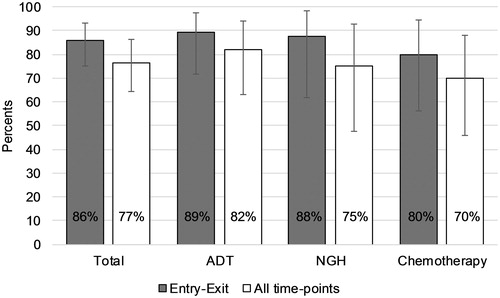Figures & data
Table 1. Patient demographics and baseline characteristics according to treatment.
Figure 1. Bar chart showing crude agreement between bone scan (BS) and 18F-sodium fluoride (NaF) PET/CT for the assessment of progressive disease vs. non-progressive disease according the Prostate Cancer Working Group criteria, in total and by treatment. In the total patient group, agreement between the bone scan and NaF PET/CT was slightly higher when looking only at whether there was progression at any time-point during the study period (grey bars) compared with the situation where time of detection of progressive disease was taken into consideration (white bars). For patients receiving androgen-deprivation therapy (ADT), these showed a slight difference, but in the groups receiving either next-generation hormonal therapy (NGH) or chemotherapy, this difference in agreement was even more pronounced. Error bars represent 95% confidence intervals. Twenty-eight patients received androgen deprivation therapy (ADT), 16 patients received next-generating hormones (NGH), and 20 patients received chemotherapy.

Table 2. Distribution of patients showing progression by BS, NaF PET/CT, PSA, and clinical response assessment.
Table 3. Number of bone metastases at baseline on BS vs. NaF PET/CT in intervals modified from Soloway et al. [Citation20].
